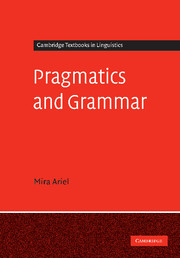Book contents
- Frontmatter
- Contents
- List of tables
- Preface
- Acknowledgments
- How to use this book
- Transcription conventions
- 1 Introduction: Grammar, pragmatics, and what's between them
- PART I Drawing the grammar/pragmatics divide
- PART II Crossing the extralinguistic/linguistic divide
- Part III Bringing grammar and pragmatics back together
- References
- Author index
- Subject index
Part III - Bringing grammar and pragmatics back together
Published online by Cambridge University Press: 05 September 2012
- Frontmatter
- Contents
- List of tables
- Preface
- Acknowledgments
- How to use this book
- Transcription conventions
- 1 Introduction: Grammar, pragmatics, and what's between them
- PART I Drawing the grammar/pragmatics divide
- PART II Crossing the extralinguistic/linguistic divide
- Part III Bringing grammar and pragmatics back together
- References
- Author index
- Subject index
Summary
Introduction
Part I was devoted to drawing the grammar/pragmatics divide, whereby grammar and pragmatics were seen as distinct and complementary. Grammar was defined as conventional code, pragmatics as extragrammatical inference. The distinction is not, however, absolute, and in more than one respect. First, the grammar/pragmatics division of labor is not topic-oriented. There are no exclusively “pragmatic” topics per se: all linguistic expressions involve both grammatical and inferred aspects (see Ariel, forthcoming: chapters 6–8). One case discussed in this book is presupposition (see again section 2.1): it is not either semantic or pragmatic. It is both. Another is reflexive pronouns. Second, as we saw in chapters 2 and 3, it is not always an easy matter to determine whether a given language use is coded or inferred, and different researchers have therefore proposed different grammar/pragmatics divisions of labor. But these difficulties do not challenge the very assumption of a division of labor between grammar and pragmatics. They only point to the difficulties in applying it to specific cases.
More challenging to the viability of a grammar/pragmatics divide are the diachronic analyses in part II, which testify that pragmatic inferences can and do cross the line to become codes. How can this be so, if grammar and pragmatics are so clearly distinct according to the code/inference proposal? The answer is that grammatical and pragmatic aspects of interpretations do interface. As Du Bois (2003b) put it, there is no discourse without grammar, and no grammar without discourse.
- Type
- Chapter
- Information
- Pragmatics and Grammar , pp. 257 - 260Publisher: Cambridge University PressPrint publication year: 2008



